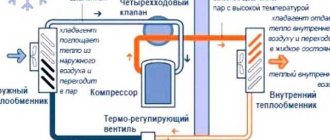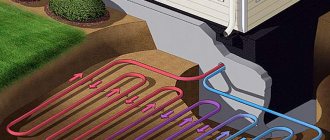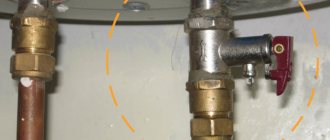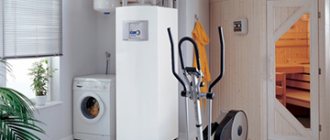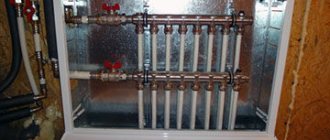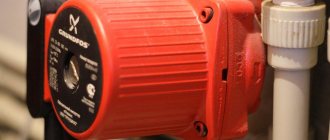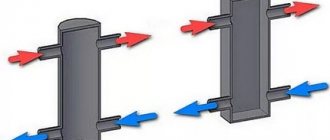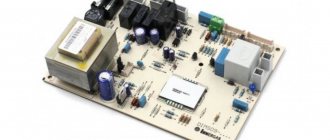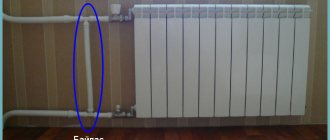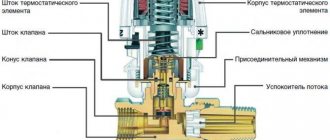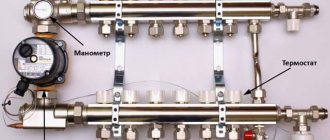The use of forced movement of coolant in the heating system significantly increases its efficiency. Owners are trying to select suitable units, and Grundfos heating circulation pumps, reliable equipment from a German manufacturer, will cope with the task perfectly.
The main requirements for these heating pumps are durability, efficiency and low noise level. Grundfos brand pumps show excellent parameters on every point.
Grundfos circulation pump design
Circulation pump with a wet rotor for a home heating system
According to their design, Grundfos heating circulation pumps are divided into two types: with a “wet” and with a “dry” rotor. The first of the designs historically appeared earlier than the second version. Its basis is a body made of cast iron, steel, bronze or aluminum, inside of which a movable rotor is located in an aquatic environment. An impeller is installed on the shaft, causing the working fluid to move.
Pumps with a “dry” rotor began to be produced a little later; the engine and the liquid in them are separated from each other. Due to liquid lubrication, first class pumps are highly reliable. But at the same time, the efficiency of such devices is very small (does not exceed 50 percent).
Units with a “dry” rotor have a slightly higher efficiency indicator (it reaches 70%). These models are most often used for industrial purposes, where operating conditions require pumping large volumes of water. For domestic needs, circulation pumps operating on a “wet” circuit are usually used.
Types of devices
The company currently offers two types:
- With dry rotor.
- With wet rotor.
With dry rotor
It should immediately be noted that this type of pumping equipment has a high efficiency. Plus it has a lot of power. These types require a large amount of coolant, so devices of this type are used either in manufacturing plants or in the heating system of large buildings. They are rarely used in private housing construction (a huge house in the form of a palace with a separate boiler room).
The design feature is a rotor that does not come into contact with water, hence the name. It is separated from the chamber where the coolant moves by a cuff.
The Grundfos dry-type circulation pump is very noisy; it is equipped with a special fan that maintains the required temperature of the unit body.
With wet rotor
For heating systems in private homes, the best option is the Grundfos UPS pump. Let's start with the abbreviation: UP stands for circulation pump category, S stands for three-speed switching system. That is, this circulation pump can operate in three speed modes, which are switched either manually or automatically.
Compared to the previous type, a pump with a wet rotor has a low efficiency of 50%. But it works silently. The only condition for high-quality operation is high quality coolant. If this condition is met, the device will work for up to 10 years guaranteed.
Experts recommend installing a Grundfos circulation pump with automation into the home heating system. Firstly, you can set the operating mode for several days. Secondly, such a unit consumes less electricity. Thirdly, there is a complete lack of maintenance process. I set the settings and no longer need to approach the equipment.
Specifications
The main technical indicators that attention is paid to when choosing a suitable equipment model are:
- graph of the dependence of liquid pressure on the amount of liquid supplied to the system;
- power consumed by the unit’s engine from the network;
- coolant performance;
- permissible temperature of the pumped medium;
- dimensions and weight of the device.
Devices are selected by power depending on the volume of water pumped.
The first of the characteristics allows you to understand what volumes of water are pumped by the pump depending on the pressure developed in the system. The higher this indicator, the less water resource must be passed through the unit to obtain the required pressure. To correctly select a sample of equipment, the operating point must be located under the graph curve. When choosing this indicator, it is advisable to ensure a supply margin of at least 20%. Another parameter is directly related to it - pump performance.
The power taken from the network is determined by the amount of current in the load and the supply voltage (220 or 380 Volts). This parameter is taken into account when selecting current protection devices for power supply circuits and when calculating the cross-section of wires included in the power supply lines. The performance of pumping equipment depends on this value, increasing with its increase.
The dimensions of the purchased sample and its weight are also taken into account when choosing a suitable model. This also applies to the operating conditions of the pump – the minimum and maximum permissible temperature of the pumped medium. The reliability and durability of the purchased sample depends on the correct selection of this indicator.
UPS 100 series
Areas of application for Grundfos 100 series circulation pumps
The main area of application for Grundfos UPS series 100 pumps is heating systems. In addition, depending on the model, they are successfully used for hot water supply systems, as well as air conditioning and cooling (for example, the UPS-K model) in cottages and apartments .
Moreover, the design and technical characteristics of the Grundfos UPS (Grundfos) UPS and UPS-K pump allow it to be used to ensure uninterrupted circulation of both cold and hot water in domestic (private) conditions.
The line of pumps in this series includes several models. In order to obtain more detailed information, as well as download the price list and find out the cost of Grundfos UPS pumps, just go to the appropriate section of our website.
Design features and technical characteristics of Grundfos circulation pumps series 100
Design Features:
Grundfos UPS series 100 pumps are pumps with a so-called “wet” rotor . It means that:
- the rotor is isolated from the stator using a sealed sleeve;
- bearings in the system are lubricated by circulating fluid;
- the electric motor and the pump itself are connected into a single unit.
By the way, Grundfos 100 series motors are an asynchronous motor . Moreover, for a single-phase network, motors are available in 1- and 3-speed versions, and for a three-phase network - in 1- and 2-speed versions. Having 3 shaft rotation speeds, such pumps are most often used in two- and one-pipe heating systems. However, they can also be successfully used in the mixing circuit of large systems.
Another design feature is the material from which the pump housing is made. Depending on the model, it can be cast iron, stainless steel or bronze , which only increases the life of the device.
Other design advantages of the Grundfos 100 series pumps include:
- Radial bearings and shaft are made of ceramic;
- The bearing plate and rotor safety sleeve are made of stainless steel;
- The impeller is made of composite heat-resistant material, resistant to corrosion;
- The thrust bearing is made of graphite.
The current catalog and description of Grundfos UPS pumps can be found on our website.
Advantages of Grundfos 100 series pumps:
- Thanks to the “wet” rotor, the pump is almost silent in operation;
- The use of stainless steel in the design increases the corrosion resistance of the pump, and therefore its service life;
- It is worth noting that pump models of the 100 series (“UP-N”, “UP(S)”) significantly save electrical energy . During operation, a time relay is connected to them, with which you can program the switching on and off of the equipment, i.e. The pump will only work when hot water is required.
Main technical characteristics of the Grundfos UPS pump (Grundfos UPS):
- The temperature of the pumped liquid depends on the model. For example, for UPS 32-30 it is +2 °C ... +110 °C, and for UPS 25-40 K -25 °C ... +95 °C;
- Installation length - 130 mm (version with reduced installation length), 180, 220 and 250 mm;
- Liquid supply volume - up to 12 m3/h;
- Pressure - up to 12 m;
- Energy efficiency class - B, C.
Advantages and disadvantages
The pump in the floor heating circuit system operates silently - it can be located in the house next to the living rooms.
The advantages of pumps from the Danish manufacturer include:
- high work efficiency;
- reliability of all components and parts;
- low level of own noise;
- versatility of application.
Grundfos pumps are used as part of heating systems and are in demand for organizing hot water supply (DHW) circuits. In addition, they can be installed in “warm floor” systems or in climate control equipment.
The versatility of Grundfos units is also evident in the fact that after purchasing them, the user will be able to work with the following types of coolants:
- water heated to a certain temperature;
- antifreeze that does not contain solid components;
- coolant with the addition of ethylene glycol in a volume of no more than 40 percent.
The advantages of equipment of this class include the operation of the rotor in direct contact with the coolant; it is separated from the other components by a metal cup made of stainless steel. In addition, in these models the inlet and outlet pipes are located at the same level, which ensures quiet operation of the entire unit. The significant advantages of products from the Danish manufacturer include:
- optimal ratio of declared price and quality;
- high energy efficiency indicators;
- a large selection of models capable of satisfying the most demanding customer;
- long service life and developed technical support system.
Characteristic disadvantages of Grundfos pumps are the relatively high price per unit of goods (from 6,500 rubles) and the absence of a cable for connecting to the electrical network.
Operating principle of a Grundfos centrifugal pump
When a Grundfos centrifugal pump operates, the pressure of the fluid moving from inlet to outlet gradually increases. This pressure difference moves fluid through the pipes. A centrifugal pump increases pressure by transferring mechanical energy from an electric motor to a fluid through a rotating impeller. The liquid flows from the inlet to the center of the impeller and further along its blades. Under the influence of centrifugal forces, the speed of the fluid increases, therefore, the kinetic energy increases, which is converted into pressure. An example of the flow part of a centrifugal pump is shown in Figure 1. Figure 1. Diagram of fluid movement in a Grundfos centrifugal pump
Fig.2. Elements of the pump flow part The principles of operation of the flow part elements are common to most centrifugal pumps. Flow path elements are parts that are in contact with liquid. The wet end components of a single stage in-line pump are shown in Figure 2. The following sections describe the components from the inlet to the outlet flange. Inlet flange and inlet
The Grundfos centrifugal pump is connected to the pipeline using inlet and outlet flanges. The flange design depends on the pump application. Some types of pumps do not have an inlet flange because the inlet is not connected to a pipe but is immersed directly in the liquid. The liquid from the inlet is directed to the impeller inlet. The design of the inlet depends on the type of pump. The four most common inlet types are in-line (in-line), single-suction, double-suction, and submersible pump inlet, see Figure 3. In-line pumps are designed for installation on straight pipe runs, which is where they get their name. . The inlet channel directs fluid to the impeller inlet. End-suction pumps have a very short, straight inlet because the impeller inlet is located in close proximity to the inlet flange. Double suction pump impellers have two impeller inputs. The incoming flow is split and fluid is supplied from the inlet flange to both impeller inlets. This design minimizes axial force. In Grundfos submersible centrifugal pumps, the electric motor is often located below the flow path, and the inlet is located in the middle of the pump, see Figure 3. This design eliminates hydraulic losses associated with the movement of fluid along the electric motor. In addition, the electric motor is cooled by immersion in liquid.
Fig.3. Inlet in inline, single suction, double suction and submersible pumps The inlet channel should create a uniform speed profile at the impeller inlet as this will ensure best pump performance. Figure 4 shows an example of the velocity distribution in various sections of the supply channel. Impeller Fig.4. Velocity distribution in the supply channel The blades of the rotating impeller transfer energy to the fluid by increasing its pressure and speed. Fluid is drawn through the impeller inlet and moves through the impeller channels formed by the vanes between the front and rear discs, see Figure 5. Impeller design is determined by pressure, flow and application requirements. The impeller is the most important part that determines the performance of the pump. Variants of Grundfos centrifugal pumps are often created only by modifying the impellers.
Fig.5. Elements of the impeller, determination of directions and flow in relation to the impeller The ability of the impeller to increase pressure and create fluid movement mainly depends on whether the fluid moves in the radial or axial direction in the impeller, see figure 6. Fig.6. Radial, radial-axial and axial impellers In radial impellers, there is a significant difference between the diameters at the inlet and outlet of the wheel, and between the diameter of the wheel and the outlet width (channel height) at the outlet of the wheel. This impeller design is used to create high pressure at low flow. Conversely, relatively low pressure and high flow are created in axial impellers, while the direction of movement does not change and the outlet width is larger. Radial-axial wheels are used when a compromise between pressure increase and flow is required. The impeller has several blades. The number of blades depends on the required performance and noise limits, as well as the number and size of solid particles in the liquid. Impellers with 5-10 channels provide maximum efficiency and are used for liquids that do not contain solids. For liquids containing solids, such as wastewater, impellers with one, two or three channels are used. The leading edge of the blades of such wheels has a special profile to reduce the risk of wheel blocking by solid particles. Impellers with one, two or three channels can pass particles of a certain size. A pump with a single-channel impeller is shown in Figure 7. Figure 7. Pump with single-channel impeller Fig.8. Vortex pump Impellers without a front disc are called open type impellers. Open impellers are used if the wheel needs to be cleaned or there is a risk of wheel blocking. Vortex pumps with open impellers are used to pump wastewater. In this type of pump, the impeller creates a fluid flow that is shaped like a tornado vortex funnel, see Figure 8. Vortex pumps have low efficiency compared to pumps equipped with disc impellers and seals between the impellers and the pump body. Once the type of impeller has been selected, impeller design is a trade-off between frictional losses and losses due to uneven speed profiles. In general, a uniform velocity profile is achieved by increasing the length of the impeller blades, but this results in increased friction.
Features of choice
The size of the union nut depends on the diameter of the connected pipes.
When choosing the right sample of pumping equipment from Grundfos, much attention is paid to the diameter of the union nuts. It is selected depending on the size of the pipe prepared for installation in the heating system:
- if a polypropylene pipe with standard sizes of 20, 25 mm is used, nuts with a diameter of 25 mm are suitable for installation;
- when using pipes of larger diameter (or steel blanks from 25 mm and above), it makes sense to purchase equipment designed for the use of union nuts with an internal diameter of 32 mm.
If the listed requirements are met, no serious problems will arise when installing the equipment if you follow the instructions.
Installation Features
The Grundfos circulation pump is mounted only on a horizontal pipeline. This is how its efficient and correct operation is ensured. Units with a wet rotor must be installed on the supply circuit, and with a dry rotor - only on the return circuit. The thing is that a pump with a dry rotor contains rubber and paronite seals, cuffs and gaskets. When exposed to high temperatures, they quickly fail.
A coarse filter must be installed in front of the unit. This small and inexpensive device will extend the life of the pump itself. Units with any type of rotor can be installed in open or closed heating systems.
If there are problems with the electricity supply in a country village, then it is best to install the circulation pump on the bypass. Coolant passes through Grundfos devices with difficulty; the gap between the impeller and the pump body is too small.
And one last thing. When choosing a pump for your own home, you must first pay attention to its characteristics. Particular attention is paid to the pressure, which determines whether the coolant will rise to the required floor or not. If the heating circuit in the house is one-pipe, then this indicator will be less; if it is two-pipe, then you will have to purchase a device with a higher indicator.
Pump energy efficiency
Well-known European manufacturers of pumping equipment have made great strides in optimizing energy consumption, introducing several wet rotor models to the market. This was achieved through the use of modern DC electric motors controlled by a controller. Such models belong to class “A” equipment, which is considered the most effective in terms of minimizing energy losses - their consumption does not exceed 0.09-1.3 kW).
Grundfos specialists have developed a whole series of energy-saving pumps under the names ALPHA2 and MAGNA3. The former are distinguished by simple functionality and are intended for use in heating and hot water systems of private houses. Models of the second type have the AUTOAdapt function, which allows you to automatically set the optimal power consumption mode. Their capabilities meet modern requirements for the efficiency and performance of equipment in this class. They are designed for use in heating systems of private homes and industrial enterprises.
Types of pumps
As for the variety of this type of pump, there are two most popular ones:
- Grundfos circulation pump for heating with a dry rotor. His photo is just below. Its peculiarity is that the motor practically does not touch the liquid it pumps. Often, such pumps are used in large systems where there is a need to pump large amounts of coolant;
- Glandless rotor pump. In such equipment, the rotor is located directly in the liquid. The main advantage of this design is that the air itself is removed when the pump starts.
Dry rotor pump
Advantages of Grundfos pumps
The Grundfos heating circulation pump has the following advantages:
- Small power, but high performance. The height of the building never reduces the performance of the device, since the water supplied by the pump to the pipeline always pushes the coolant in the opposite direction;
- Minimal energy losses occur only due to friction in the pipeline;
- Significant energy savings. This is explained by the fact that the pump maintains the desired temperature in autonomous mode;
- All modern systems of this type are equipped with special temperature controllers. You can set the desired temperature on this sensor and then the system will maintain it itself. The pump can quickly adjust to the desired mode and maintain the already set temperature;
- Circulation pumps for Grundfos heating systems are characterized by a simple design. If desired, you can install such a unit yourself without the involvement of knowledgeable specialists;
- The buyer can select the appropriate pump for a specific system. It should be noted that the price will depend on the configuration of the device. All this allows the buyer to significantly save his own money;
- A huge plus is the practicality and reliability of circulation pumps. There are no unnecessary functions and parameters;
- Possibility of purchasing through the online catalog from an official dealer thanks to the provided photos and videos of pumps.
Installation process
Features of Grundfos pumps
The Danish company Grundfos is a leader in the design of high-quality pumping equipment. It covers half the needs of the entire world market. This company is trusted by millions of people, as it has successfully established itself in the sales market of circulation pumps and equipment of this type.
Special requirements are always put forward for the equipment of this company due to the fact that such systems must operate continuously and autonomously. Also, a huge advantage of Grundfos pumping units is high-quality warranty service.
Typically the warranty period is twenty-four months from the date of purchase. Instructions are included with all pumps.
An open heating system is the best choice for a country house - read about it here.
Operating modes
A modern recirculation pump for heating is a multifunctional device. Various samples of this equipment are capable of operating in the modes indicated in the passport, including “fixed speed”. All of them are equipped with a synchronous motor, the operation of which is controlled by a built-in processor. During operation of the unit, the control unit records the following main parameters:
- current strength;
- rotor speed;
- temperature in the working area and others.
Its presence allows you to adapt to a specific heating network with optimal energy consumption.
Do-it-yourself pump disassembly
If repairs are necessary, the equipment must be taken to a service center if the device is under warranty.
Any user who has thoroughly studied the design can disassemble a purchased sample of pumping equipment if desired. The need for this often arises when it is necessary to repair or overhaul it with the replacement of worn parts. After complete disassembly, the main working components of the mechanism are inspected and then checked for wear.
The main attention is paid to examining the condition of the “wet” rotor. It should be removed and replaced with a new part in the presence of a repair specialist who can supervise this difficult operation.
